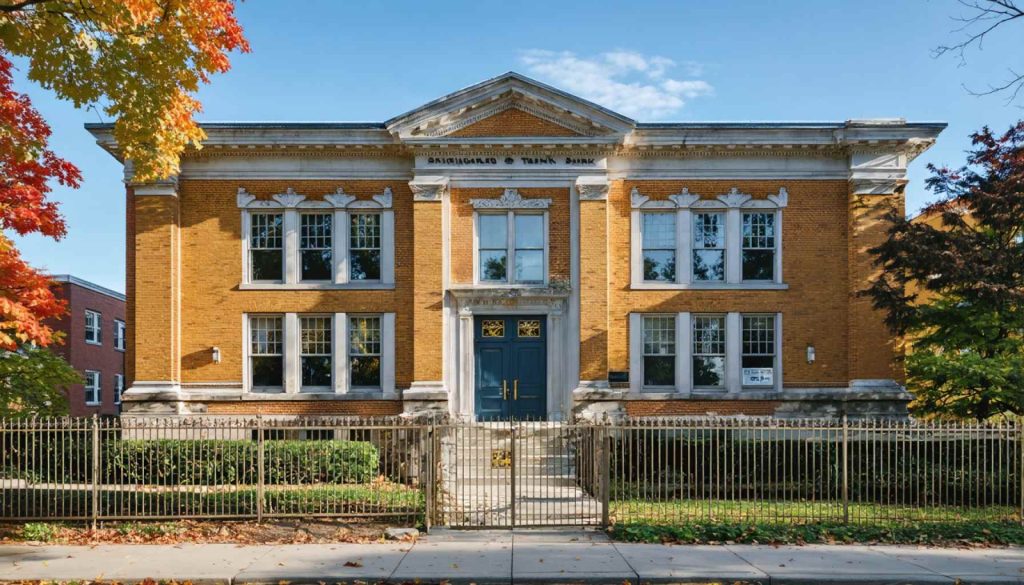
- The historic Park Street schoolhouse in Springfield, Vermont, is transforming into the Black River Innovation Campus (BRIC), redefining local entrepreneurship.
- BRIC, led by Executive Director Vin Fusca, is revitalizing the structure with a $7.2 million investment, including new apartments and renovated community spaces.
- Key programs include the Actuator, an eight-week course that develops tech-driven start-ups, and STEAM initiatives aimed at youth education.
- The Cultivator initiative expands BRIC’s reach, offering co-working spaces and business training beyond Springfield.
- BRIC emphasizes Vermont’s strengths: a tight-knit community and a collaborative spirit, as keys to fostering sustainable economic growth.
- The project is a tribute to resilience, transforming historical buildings into vibrant centers for innovation and community development.
Nestled in the heart of Springfield, Vermont, the historic Park Street schoolhouse is undergoing a metamorphosis that could redefine the town’s future. The Black River Innovation Campus, or BRIC, is sparking an entrepreneurial revolution amid its charming red brick exterior and vintage hallways. It’s not just a makeover of a building; it’s a blueprint for a brighter economic horizon.
Imagine the creak of the school’s aged wooden floors, now giving way to the energetic pace of budding entrepreneurs. Built in 1895, this venerable structure stands as a testament to time, and under the watchful guidance of Vin Fusca, BRIC’s Executive Director, it’s morphing into a hub that intertwines business acumen, innovation, and community spirit.
The ongoing $7.2 million transformation is not merely cosmetic. It will breathe life back into the grand old gymnasium and the 500-seat theater, where whispers of history meet the echoes of future ventures. Plan the setting of 23 new market-rate apartments, making it a crucible for ideas that could craft the next wave of Vermont’s business landscape. “The acoustics here are phenomenal,” Fusca says, his voice brimming with optimism for the revival.
However, it’s not just about renovations. BRIC trains entrepreneurs to birth technology-driven enterprises. The Actuator program, an intensive eight-week course, polishes raw ideas into viable start-ups. Here, participants from as far as Boston and New York discover the potential of Vermont’s tight-knit community. Unlike urban centers, the state’s strength lies in its intimately connected population, who openly share their expertise and time.
But the reach goes beyond adults. Last summer, BRIC’s initiative for youth unfolded with STEAM programs, integrating science, technology, engineering, arts, and math into the lives of young learners. From after-school workshops to a five-week summer camp that filled instantly, BRIC molds the next generation to thrive in futuristic workplaces.
Even the reach of BRIC’s innovation isn’t confined to Springfield. The Cultivator initiative extends a hand to Randolph, offering co-working space and entrepreneurship training, proving the efficacy of collaborative ventures. Abbey Salomon, with her seasoned banking and business strategy background, guides aspirants towards entrepreneurial success.
The guiding ethos? Foster an ecosystem where community uplift and innovation lead to sustainable economic growth. Fusca expresses a sentiment echoed by every wall of the schoolhouse: Vermont, though small, is bustling with potential. “We’re small but mighty,” Fusca remarks, emphasizing that Vermont’s landscape is fertile not just in soil, but in spirit.
In the Park Street schoolhouse, BRIC is crafting more than just a business incubator—it’s building a sanctuary where ideas flourish, communities thrive, and history finds its modern muse. This isn’t merely bringing an old building back to life; it’s an ode to resilience, and an invitation to dream fearlessly in times that demand transformative ingenuity.
Unveiling the Future of Innovation: How an Old Vermont Schoolhouse Transforms into a Hub for Entrepreneurs
Park Street Schoolhouse: A Beacon of Entrepreneurial Transformation
The historic Park Street schoolhouse in Springfield, Vermont, represents a groundbreaking initiative to fuel economic growth through innovation and community development. Under the leadership of the Black River Innovation Campus (BRIC) and guided by Vin Fusca, this schoolhouse is undergoing a $7.2 million transformation to become a thriving hub for entrepreneurs, public initiatives, and local economic revitalization.
Facts and Insights About BRIC’s Transformation
1. Architectural and Cultural Revival:
The restoration of the schoolhouse maintains its historical essence while incorporating modern design elements. The revitalization project includes the following features:
– Restoration of the grand gymnasium and 500-seat theater, preserving the original acoustics valued by both historians and modern users alike.
– Conversion of sections into 23 market-rate apartments, creating a dynamic live-work environment for residents and entrepreneurs.
2. The Actuator Program: Turning Ideas into Viable Start-Ups:
BRIC’s eight-week “Actuator” program empowers budding entrepreneurs by equipping them with essential tools and mentorship to transform raw ideas into operational start-ups. Participants benefit from:
– Mentorship from technology and business experts.
– Hands-on experiences in developing and launching start-ups.
– Engagement with the Vermont business community, encouraging collaborations and networking opportunities.
3. Community-Driven Innovation:
BRIC emphasizes community involvement as a key component of its training programs. Entrepreneurial activities extend beyond the schoolhouse:
– BRIC’s Cultivator initiative offers co-working spaces in Randolph, highlighting collaboration’s role in business strategy.
– Programs fostering youth engagement with STEAM (science, technology, engineering, arts, and math) subjects, preparing younger generations for future technological landscapes.
Real-World Use Cases and Market Forecasts
Use Cases:
– Entrepreneur Retreat: Entrepreneurs from larger urban centers are attracted to the collaborative and intimate environment offered by BRIC, providing a stark contrast to the bustling, competitive atmosphere of cities like Boston or New York.
– Community Integration: The schoolhouse not only serves entrepreneurs but also members of the wider community, who benefit from cultural events hosted in the renovated theater.
Industry Trends and Forecasts:
– The demand for flexible workspaces and business incubation centers is expected to grow as remote work and decentralized business models become the norm. BRIC is poised to be at the forefront of this shift, particularly in rural and semi-urban areas.
Pros and Cons Overview
Pros:
– Promotion of local entrepreneurship and community-building.
– Revival of a historic landmark with modern amenities.
– Diversified programs catering to both adults and youth.
Cons:
– Challenges in maintaining the balance between historical preservation and modern functionality.
– Potential for high initial costs before revenue from initiatives is realized.
Recommendations and Tips
– Embrace Collaboration: Entrepreneurs and innovators are encouraged to tap into Vermont’s strong network of business mentors and community leaders to foster growth and sustainability for new ventures.
– Engage with BRIC Programs: Whether through youth STEAM initiatives or the Actuator program, participating in these offerings can provide invaluable insights, connections, and tools for success.
To explore more about how you can engage with the entrepreneurial ecosystem in Vermont, visit the official Black River Innovation Campus site.
BRIC continues to position itself as a model for innovation hubs across the country, demonstrating how historical architecture combined with forward-thinking can generate a fertile environment for entrepreneurs and community growth.



